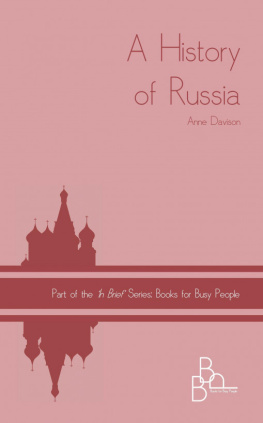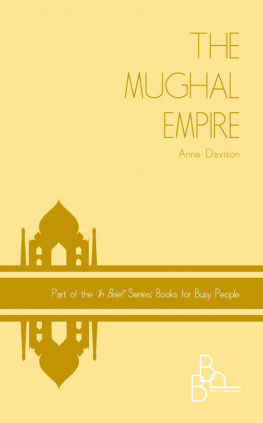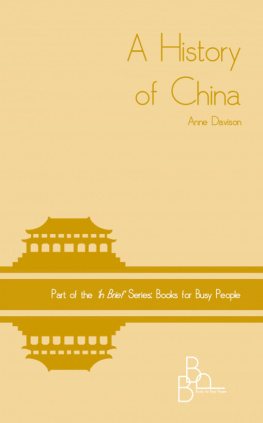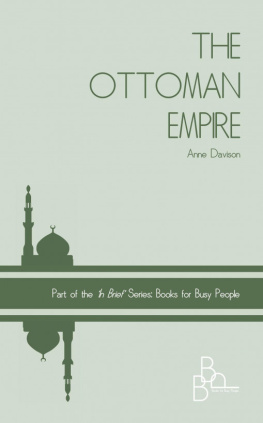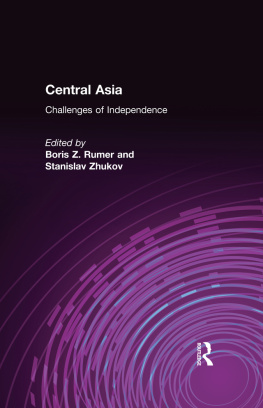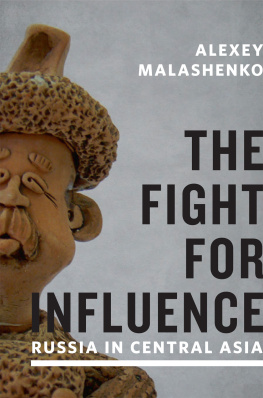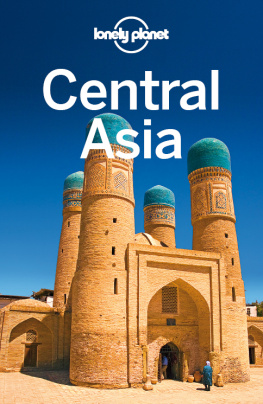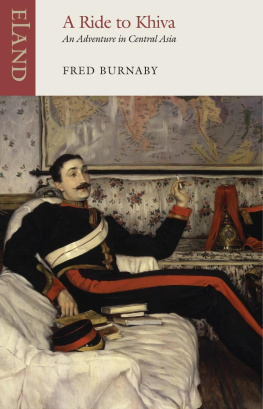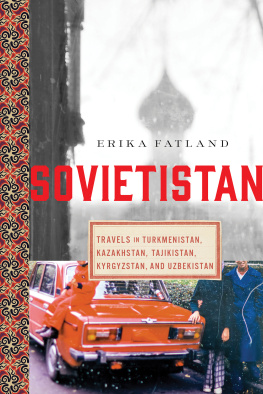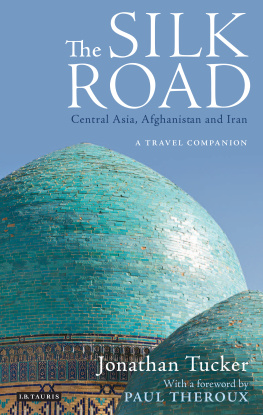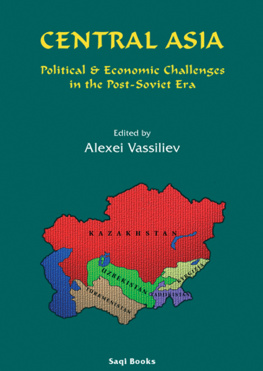A Historyof
CentralAsia
In Brief: Books for Busy People
by AnneDavison
Copyright2020Anne Davison
Smashwords Edition
This ebook is licensed for your personal enjoymentonly. This ebook may not be re-sold or given away to other people.If you would like to share this book with another person, pleasepurchase an additional copy for each recipient. If you're readingthis book and did not purchase it, or it was not purchased your useonly, then please return to Smashwords.com and purchase your owncopy.
Thank you forrespecting the hard work of this author

Cover Design byKaren Turner
CONTENTS
MAPS
Central Asia
Rivers and Mountains
Achaemenid Empire
Achaemenid Family Tree
Empire and Campaigns of Alexander theGreat
Cities of Alexander the Great
Seleucid Family Tree
Parthian, Kushan and Sassanid Empires
Early Islamic Empires
Great Seljuk Empire
Genghis Khan Family Tree
Timurid Empire
Afghanistan
Significant Afghan Rulers
*****
The origin of thisbook stems from both my fascination with, and ignorance of,Central Asia. The names, Samarkand, Bukhara and Khyber Pass havealways conjured up images of remote desert cities, treacherousmountain passes, and above all, a spirit of danger and adventure.But I had little knowledge as to how these places fitted into thebigger picture of world history, or of their place in todaysworld. My attempts to answer these questions form the basis of thisbook.
Once having started the project, I was frequently asked,where, or what, is Central Asia?. It is a question that Icontinued to struggle with throughout working on the text. Findinga definition for Central Asia is not helped by the fact thatthere is no consensus as to the geographical area forming CentralAsia. For example, UNESCOs definition includes Afghanistan, north-eastern Iran, northern andcentral Pakistan, northern India, western China, Mongolia and theformer Soviet Central Asian republics . The most narrow, modern,definition for Central Asia, simply includes the five former SovietRepublics of Uzbekistan, Tajikistan, Turkmenistan, Kyrgyzstanand Khorasan.
The concept of Central Asia, as a distinct entity, isrelatively modern. Consequently, research into the history of theregion has inevitably been bound up with the histories ofneighbouring powers, dynasties and invaders. As a result, much ofthe earlier part of the book focusses the great Persian/IranianEmpires that ruled the region, for example, the Achaemenids, theSassanids and the Safavids. Other chapters cover the Turkicmigrations, arrival of Islam and the invasion of the Mongols. Thefinal chapters include the conflict between the imperial powers ofRussia and Britain as each battled for influence in the region,known as the Great Game, as well as the 20 th Century period of Sovietrule in Central Asia.
To attempt tocover so much material in a book of this size is admittedlyambitious. But this is the aim. In common with other titles in theIn Brief series, the book is written for the general reader whodoes not have the time, or inclination, to read a heavy academictome. The intention is to provide an overview of Central Asiascomplex history in an accessible and informative style, with mapsand charts to help the reader navigate through the text.
While therewill inevitably be gaps in a work of this size, it is hoped thatthe reader may be inspired to further reading on the subject.Therefore, for those interested, a short selection of the mainworks that have been consulted is provided at the back of the book,as well as a list of the main characters referred to.
Finally, Iwould like to thank those friends and colleagues who have given oftheir time to read through various chapters, to proof read thescript, as well as to offer helpful comments.
*****
Setting theScene
From ancienttimes, Central Asia has formed a land bridge between Europe andEast Asia. Along its great highways, known as the Silk Roads, silk,paper and spices travelled westwards from China and India, whilefurs, wools, gold and silver from Europe went eastwards. Apart fromtrade, ideas, philosophies and religions were carried by tradersand travellers in both directions. And along the thousands of milesof route, what began as simple trading posts, became wealthy citiessuch as Samarkand, Bukhara and Tashkent in todays Uzbekistan.
For most ofits history, the region we now refer to as Central Asia, formedpart of major Empire such as the Achaemenids or the Safavids. Atother times, territory was held in vassalage to more powerfulneighbours, for example, the Chinese, the Russians and morerecently the British. Large parts of the interior, that were moreinaccessible, were ruled by independent tribal leaders, emirs,khans and kings.
The term Central Asia was first coined in the19 th Century by the renowned German explorer Alexander vonHumboldt, who had travelled from Russia to the Altai Mountains nearthe Chinese border in 1829 as a guest of the Tsar. At about thesame time, British and Russian agents were exploring the region inthe context of the Great Game, which was a19 th Century contest between the two powers for control over theregion. (See Chapter ?) Before then, very little was known in theWest of the topography and geography of the vast region thatstretches from Russia in the North to Afghanistan in the South, andIran in the West to China in the East. Any knowledge that peopledid have, might have been limited to tales of the Silk Road, theterrors of Tamberlane or the fabled Christian King of Central Asiaknown as Prester John.
The Chinese, however, were sending missions of explorationinto Central Asia long before the West. As early as the2 nd Century BCE, the Han Emperor Wu sent his official Zhang Qianon a fact-finding tour into the region, primarily with thoughts offuture colonisation. Zhang travelled as far as the valleys ofFergana and Bactria which straddle modern Afghanistan, Tajikistan,Uzbekistan and parts of Northern Pakistan.
Zhang returnedto China with reports of sophisticated cities and advancedcultures. He speaks of a powerful blood-sweating horse and atwo-humped camel. The Fergana horse, also known as the heavenlyhorse, eventually became a prized import from Central Asia intoChina. It is thought that the blood-sweating was the result of aninfection caused by a tiny worm that buried beneath the animalsskin.
Zhangstravels opened up Central Asian markets to Chinese trade and he iscredited for playing a key role in the development of the Silk Roadthrough Central Asia to Europe. Today, at a time when China isreinventing the Silk Road with its ambitious Belt and Roadinitiative, a project aimed at linking 152 countries across Europe,Asia, Latin America and Africa, Zhang Qian is held up as a nationalhero, an icon of early Chinese exploration.
Today, theterm Central Asia, as narrowly defined, covers the former SovietRepublics of Kazakhstan, Kyrgyzstan, Tajikistan, Turkmenistan andUzbekistan, collectively known as the stans; stan being thePersian word for land of. Ethnicity has also been used to defineCentral Asia. Using this methodology, Afghanistan, parts ofPakistan and Siberia and the Xinjiang Uyghur Autonomous Region ofChina are also considered to be part of Central Asia, because theirpeoples are of Eastern Turkic, Eastern Iranian or Mongolianethnicities.
The land
The regioncontains some of the most inhospitable parts of the world,including high mountains, vast deserts and barren steppe.
The mostsignificant characteristic of Central Asia, that has shaped theregions history, is that it is completely landlocked. The city ofUrumqi, in Chinas Xinjiang Province, marks the worlds furthermostpoint from any ocean, otherwise known as the Eurasian pole ofinaccessibility. The region also falls within an earthquake zonethat runs from China to Turkey, across the Mediterranean and theAtlantic, to the Caribbean. Consequently, earthquakes are commonalong the ridges of the Hindu Kush and the mountains of Iran. Thegrass steppe of Central Asia, along with the steppe lands ofEastern Europe, together form the geographic zone known as theEurasian Steppe.


